CHCDIV001 Work With Diverse People Assessment
- Subject Code :
CHCDIV001
- University :
Eduworks Resources Exam Question Bank is not sponsored or endorsed by this college or university.
- Country :
Australia
Question 1
Answer the following questions.
- In your own words explain the concepts and definition of diversity.
- In your own words, explain the concepts of cultural awareness. Consider the work roles in your preferred industry and write down how an understanding of cultural awareness can be of benefit to relationships with others in the workplace.
- In your own words, describe the concepts of cultural competence and its impact on those employed in community services.
- In your own words, describe the concepts of cultural safety and its impact on community service workers.
- What ways could an organisation and its staff develop cultural competence? Provide at least three strategies.
Question 2
- Describe the legislative and ethical rights and responsibilities of employees, employers and clients to ensure a culturally safe and diverse work environment and care experience. List in your answer the types of requirements that must be adhered to.
- What actions can a client take if they feel an organisation is being discriminatory and not taking due care to meet their cultural needs?
Question 3
Terese a new client in a full-time care facility who requires more care than her family is able to provide. Tereses family have historically been able to take her to all her appointments, however due to an increase in the number of appointments required for Terese, they are no longer able to provide her with the level of support she needs.
Terese speaks only a limited amount of English but can mostly understand what is being said to her. Her family has always communicated to others for her, and have previously taken her to all doctor appointments, specialist appointments and even banking and other daily needs.
- Explain the role of a language interpreter and how it differs from a cultural interpreter. Explain which interpreter is required in this scenario and how it will help Terese.
- Tereses family has given permission that the services of an interpreter can be used. Use the Internet to locate an interpreting/translation services provider in your own local area. (You can choose Tereses cultural background to locate specific translation/interpretation services.) Write down their name, address and telephone number.
Question 4
A group of care workers are planning a social night out. Their manager is organising dinner at a local pub, and advises staff they are welcome to bring a friend or partner and to respond via email of their acceptance and if they will bring someone.
A new employee, Tom, is keen to attend its a great opportunity to be social and get to know his new colleagues in a more relaxed environment. He decides he will bring his partner of 5 years, Dave.
Tom responds to the email invite his manager has sent out, saying in the body of the email that Dave will attend too.
The next day, the date of the dinner changes due to a number of staff being unable to attend . Tom accepts the new date. Two days later it changes again. He is unable to attend this time, Dave has his own work function and Tom always attends them.
A couple of days later, Tom is in the lunch room telling a colleague about Daves work function and how much of a good time they had. Two staff get up and leave the kitchen during this chat.
The colleague tells Tom its fantastic that Daves work is so accepting, and rolls their eyes in the direction of those who departed the room.
Tom discovers that some people in the department were uncomfortable with the idea of Dave going to the dinner, and that the manager kept changing the dates with the hope that Tom would be busy, and that the rest of the staff could still come.
- Identify the type of legislation and types of workplace procedures that have been breached and how.
- Explain how this situation can impact the cultural safety of the workplace.
- Explain how this situation can impact Tom socially and professionally. Consider in your response the impact on his relationships with others in the workplace and his relationship with Dave.
- Explain actions that Tom could take in this situation. Imagine that his workplace does not handle the situation and Tom continues to be excluded. What could he do next?
Question 5
- Describe the purpose of the Universal Declaration of Human Rights.
- Explain how this situation can impact the cultural safety of the workplace.
- Explain how this situation can impact Tom socially and professionally. Consider in your response the impact on his relationships with others in the workplace and his relationship with Dave.
- Explain actions that Tom could take in this situation. Imagine that his workplace does not handle the situation and Tom continues to be excluded. What could he do next?
Question 5
- Describe the purpose of the Universal Declaration of Human Rights.
- Do human rights necessarily cover all human needs? Explain your answer in one paragraph and provide an example.
- Apply the Universal Declaration of Human Rights to Toms situation at Question 4 above. What fundamental rights has Tom been refused?
Question 6
- List at least three effective strategies that could encourage effective communication in a situation where there is a language barrier.
- List two strategies you could use if you were involved in a cross-cultural conflict with a work colleague and needed to sensitively resolve it.
- Describe the effectiveness of visual imagery when communicating information to diverse audiences.
- Provide at least three examples of universal imagery or colours used within the workplace (you may draw examples where required).
Question 7
- Explain how diversity has impacted Australias ever-changing economic, employment, social, cultural and political landscape. Write at least one paragraph for each area.
- Using at least three paragraphs, now write about how Australias diverse community has been impacted (consider both positives and negatives) by the changing economic, employment, social, cultural and political landscape.
Question 8
- Key areas of diversity have been listed below. Provide answers to each question. Note: remember to be sensitive and respectful in your definitions and responses.
- For each group, identify one way that the groups characteristics inform how you provide care and services to them.
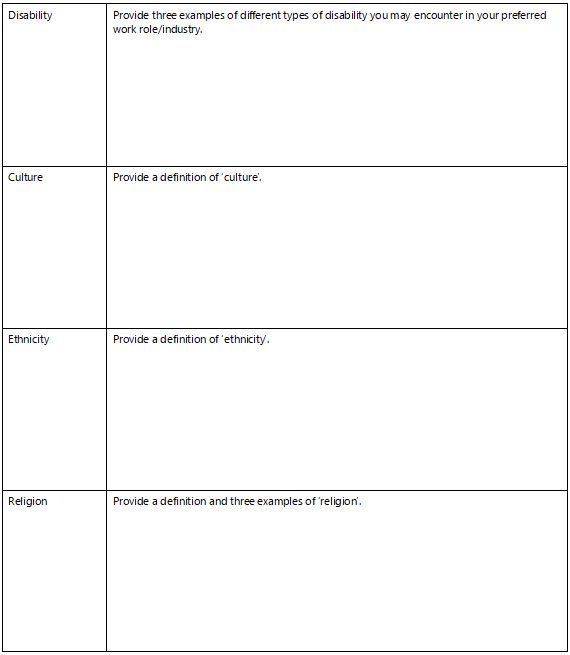
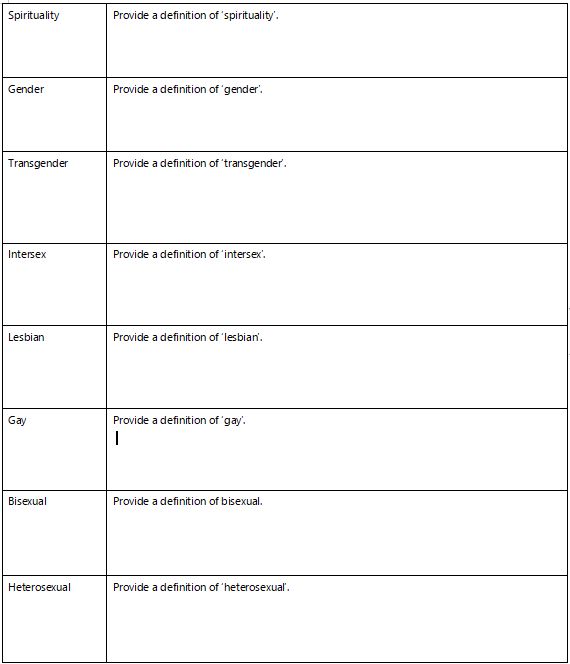
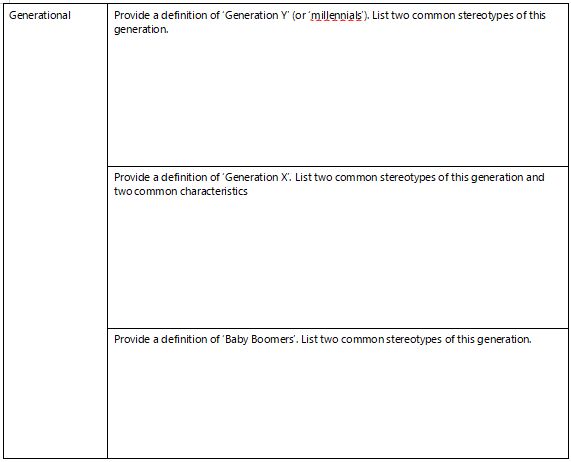
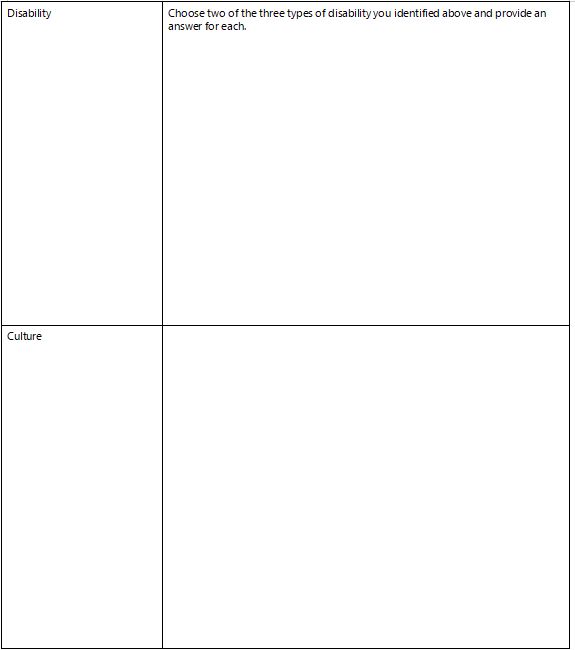
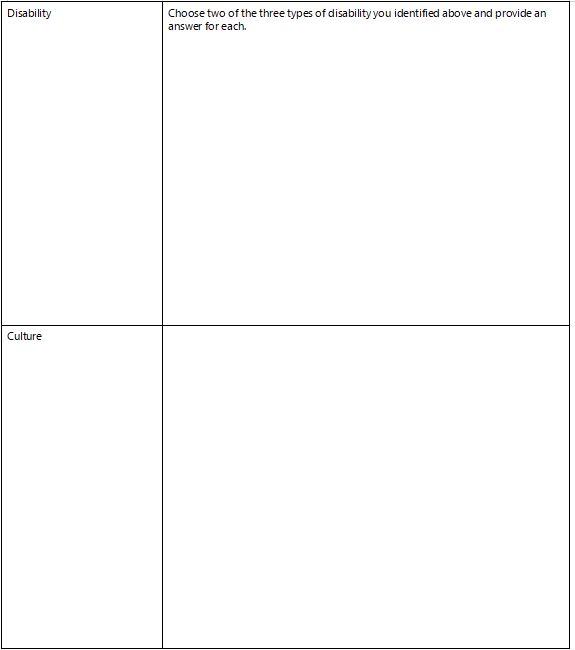
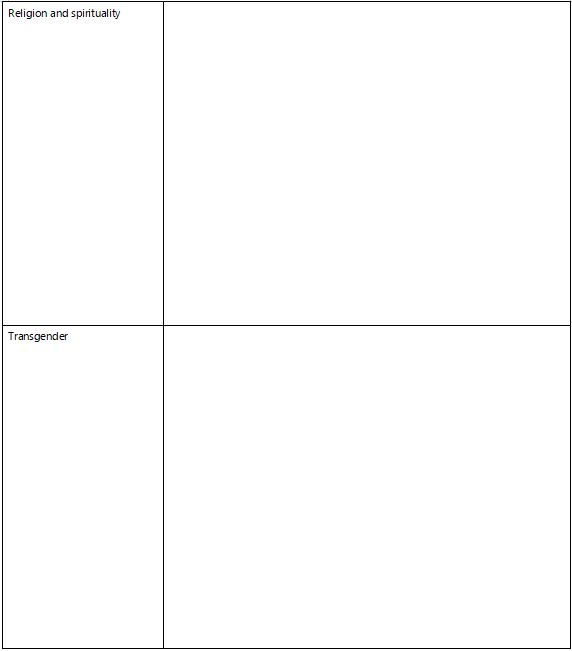
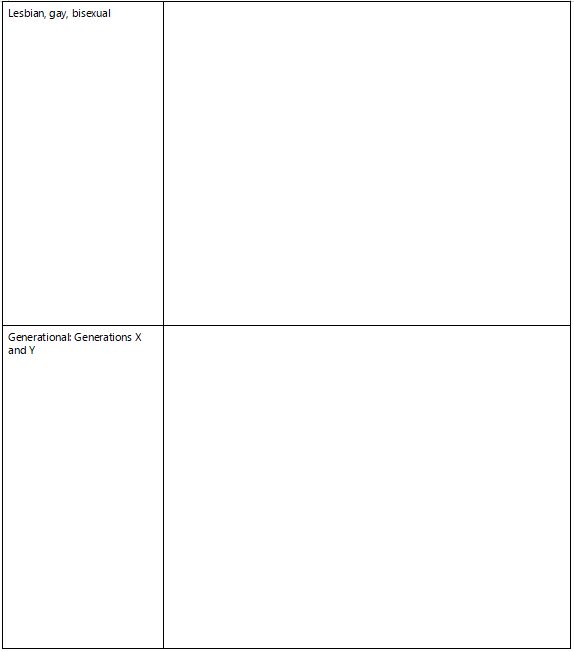
Question 9
Martin, 58, is sitting in a conference room being interviewed for a job. It is all going well, but then one interviewer asks how old he is, as his date of birth wasnt indicated on his resume.
Martin refuses to give his age he states that his age is not an indicator of whether he can do the job well, but his work experience, knowledge and strong references should be what proves his abilities.
Martin does not get the job. A friend who works in the organization tells him that they employed a 25-year-old female because they felt a younger person with a soft approach would be best for the position.
- Answer the following questions about Martins situation.
- What breach has the workplace committed?
- What could be the consequences of this scenario?
- What do you think would be the impact on Martin in this situation?
Giovanni has a guide dog. One day he is out with his carer, Cathy, who suggests they stop by one of her favourite cafs for something different. As Giovannis guide dog is working, it is harnessed.
They approach a table and start to sit down. An employee quickly meets them and quietly asks them to leave. Cathy is taken aback and asks why. The employee states that pets are not permitted inside.
Cathy says that Giovannis pet is clearly a guide dog and they are allowed in the premises health regulations have exemptions for guide dogs.
The employee says their manager has requested they leave and they cannot do anything more for them. - Answer the following questions about Giovanni and Cathys situation.
- What breach has the caf committed?
- What could be the legal consequences of this scenario?
- What do you think would be the impact on Giovanni and Cathy in this situation?
Umair has finished his qualification. He has passed all his assessments and the feedback from his trainers has been very positive.
Umair is very excited to get a job he enquires at his placement organisation, but unfortunately, they do not have any jobs available at the moment. The manager promises to let him know if any jobs are going to be advertised, as she was very impressed with his work.
Umair finds that a lot of his job applications do not lead to any interviews. With the urging of his friends, he decides to call the last workplace his applied to and ask why he wasnt considered for an interview. He is put through to someone called Bri, who says, Oh Umair, thats right. I heard about you. Yes, the manager didnt want to put your application through further because they thought some of our elderly clients might be unsettled by a Muslim on the staff.
Umair hangs up in shock he cant believe what he has just heard! - Answer the following questions about Umairs situation.
- What breach has the workplace committed?
- What could be the consequences of this scenario?
- What do you think would be the impact on Umair in this situation?
- Review the Universal Declaration of Human Rights and identify Article/s that are being breached in Umairs story.
Question 10
- Explain why some people experience marginalisation.
- Explain how those in marginalised groups may be impacted by trauma, discrimination, negative attitudes and exclusion. In your response, refer to the needs of:
- people with disability
- those who are ageing
- those with mental health/emotional issues.
- List three protective factors that can help those in marginalised groups to cope.
Question 11
In a short paragraph, describe at least three cultural biases or social expectations which may exist when working with:
- Someone of an older generation.
- A person with a disability.
Are you struggling to keep up with the demands of your academic journey? Don't worry, we've got your back! Exam Question Bank is your trusted partner in achieving academic excellence for all kind of technical and non-technical subjects.
Our comprehensive range of academic services is designed to cater to students at every level. Whether you're a high school student, a college undergraduate, or pursuing advanced studies, we have the expertise and resources to support you.
To connect with expert and ask your query click here Exam Question Bank

